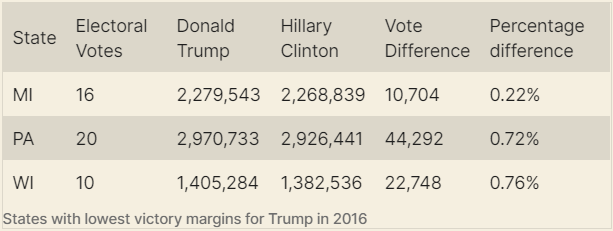When most Trump supporters, and some non-supporters, argue that just like 2016, all polls are fake news and Trump is going to win “bigly” again, they forget to look at one simple fact — Trump’s victory in 2016 was almost a fluke. If 40,000 voters in a country of 325 million people had changed their mind, he would have lost the election.
Let’s get down to brass tacks. The three states where Trump’s victory margins were the lowest were Michigan, Pennsylvania, and Wisconsin (0.22%, 0.72%, and 0.76% of total vote respectively). This resulted in a switch of 46 electoral votes, without which Trump would have had 258 electoral votes and would have lost the election. The total number of votes that made up the above-mentioned victory margins across three states was 77,744. This means that if a little over half of these voters had switched sides, we would have seen a completely different political landscape in the country. That is, Hillary Clinton would have been president.
Following are the raw numbers that make up the above calculations:

You can get the raw data from Federal Election Commission’s website yourself in the form of a spreadsheet by clicking here, and play with the numbers yourself.
Now what are your take aways from this data? Mine are as follows:
- Is it possible for Trump to pull off a similar feat this year? It absolutely is. Can it be taken for granted? Absolutely not. Some people may think Trump has gained more supporters in these four years; others may think that those who wanted to give him a chance last time will not want to do so again. It all depends on how happy you are with what he did with the country.
- Were the 2016 polls nowhere close to reality? The answer to that question is a mixed bag. If we look at Real Clear Politics’ poll of polls for 2016, the RCP average for these three states (MI, PA, WI) was +3.6, +2.1, and +6.5 in favor of Clinton. Even though two of those numbers turned out to be within the margin of error, it is hard to give a certificate of reliability to these polls. I would, however, not go so far as to agree that the polls were manipulated to look bad for Trump. One pollster who seems to have predicted Trump’s 2016 win was Republican pollster Robert Cahaly of Trafalgar Group, and he is sticking by Trump again in 2020.
- The electoral college, in particular the winner-take-all rule of most states, messes up the results and in effect disenfranchises large groups of voters. When many electoral districts in rural NY and CA vote Republican, why should all their electors vote Democrat? And when many electoral districts in urban TX and FL vote Democrat, why should their electors vote Republican? Keep the electoral college, if you must, but split the electors according to vote percentage.
- These numbers put into perspective how few people can swing the results of such a large and significant election. If the foreign efforts to impact the election were to be successful, they didn’t have to convince too many people.
Leave a Reply